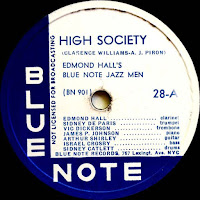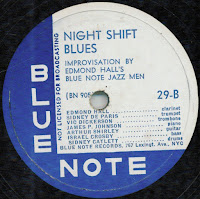Edmond Hall's Blue Note Jazz Men – November 29 1943
Art Hodes – B-6505 Liner Notes
Edmond Hall is leader-man. Dickenson is on trombone; Sidney DeParis takes over the trumpet seat. It's Israel Crosby on bass; Arthur Shirley, guitar; James P. Johnson, piano; and Big Sid Catlett, drums. I submit that's one fine organization. "High Society" is given a four-beat treatment, although the tune itself is cut from 2-beat thread. Where does one begin passing out credits? Big Sid is too much. Man, he had a beat that wouldn't quit. Then the DeParis horn hits you and you realize there actually was a time when such music was played and trumpet players were something to listen to, not to figure out. Edmond handles the traditional clarinet (Picou) chorus with ease. You'll love the way Catlett walks this on down to the finish.
"Blues At Blue Note" follows the two "High Society" versions. Now it's Sidney's muted style stating the blues. He sets the mood. Man, I feel his "depth." This isn't surface talk. The growling Dickenson trombone adds the earthy touch. James P. takes a chorus. I regard Jimmy with reverence. He was Big Daddy (although this tempo blues isn't his bag), and if you listen there's always somethin' you can learn when he's playing. "Night Shift Blues" begins with "rhythm" talk and it's Shirley and his guitar that sets the mood. One by one (trombone, trumpet, clarinet) the players take their choruses and you hear some good riff backgrounds cooked up by Dickenson and DeParis. They sound especially good together on this blues.
"Royal Garden Blues" has been jazz band material since the Bix days. Each band that tackles it sticks pretty close to standard format. This group is no exception. What I really noticed was how they kept the ensemble playing going long enough so that when the first soloist came in (it was Vic Dickenson) the thing was off the ground. You call the jazz this band produced like "down-the-middle." We used to say "it's tight like that," and it is. Don't nobody move. Now you hear a bit of the Johnson piano live been hearing for years. And towards the close you hear some of the best drummin' ever, but no "I'm takin' over" style. The drummer is still a part of the whole. Man, this is music.
Downbeat – March 15 1944 – Volume 11 Issue 6
These, like the [James P.] Johnson Blue Notes [Blue Note 26, 27, 28], are twelve-inch discs. Hall has collected a formidable group here, and the musicians play as if they had been working on same bandstand for half a generation. Society, the Williams-Piron standard, is probably the best of the four sides, although choosing is in this case very difficult. The pattern for Society is that followed. more or less, during the entire session. It begins with an ensemble chorus. Hall comes in for a solo, interrupted only by a Dickenson trombone break. Then Vic, playing his own break, takes a solo by himself. Next De Paris continues with a chorus and break of his own. Then, as a clincher, Ed takes the traditional Picou clarinet passage. Finally, a sensational all-out ensemble closes the number, broken only by a Catlett break on drums. Blue Note, an original, is a subdued effort full of taste and packed with subtle nuances. Royal Garden, on which Clarence and Spencer Williams combined their talents, is here done better than it has been in years. Trumpeter De Paris and trombonist Dickenson. both of whom have long deserved a great deal more recognition. excel individually. Night Shift, another original has some marvelous work by James P. on piano, Arthur Shirley on guitar, and Israel Crosby on bass. Hall, of course, stands out on every side, a truly great clarinetist! (Blue Note 28, 29)
Max Margulis – Blue Note 28, 29 Marketing Brochure
BLUE NOTE's latest releases are an ideal measure the quality and intensity of present-day sensibility in jazz. A group of seven peerless musicians, led by the famous clarinettist EDMOND HALL, playing selections listed here, and basing their performance upon fundamental expressive forms. provide these forms with a content wholly of this decade.
If is a truism that different historical periods require an altered content, and today our music is urbane, with new patterns and a complex of subtleties based on new patterns and a complex of subtleties based on new technical resources. But the character and force of expression remain, as ever, the essential criteria by which we judge jazz music.
The present records have authentic expressiveness, and their unity of performance is a mingling and blending of distinct, individual musical voices. Each musician is simultaneously soloist and ensemble player. For example, in "'Night Shift Blues," the so-called "rhythm" section, consisting of JAMES P.
JOHNSON. piano, ARTHUR SHIRLEY. guitar, and ISRAEL CROSBY, playing alone for two choruses. develop a rhythmic and harmonic motif in a "solo" sense: SIDNEY D PARIS. trumpet, VIC DICKENSON. trombone, then play a duet of closely spaced independent melodies, creating an overwhelming rhythmic pattern; then the fine clarinet solo. played by EDMOND HALL, has a rhythmic background given by trumpet sotto voce. Similarly. in ' 'High Society." the weIl-known characteristic New Orleans march piece, the "rhythm" section, which now prominently includes SIDNEY CATLETT, drummer, playing as a percussion group, creates a constantly shifting emphasis or change of background with each successive chorus, so that the group begins to take on the nature of a solo instrument. while the melodic variations take on the nature of on accompaniment.
These details and their creative use are possible only today, based as they are on an awareness of the past. By the same token, the organic unity of mood in "Blues at Blue Note." growing out of the subdued character of the four-bar introduction. is an exclusive product of present-day feeling. Finally, note the transformation in "Royal Garden Blues" of the peculiar quality of feeling of '20's as know it in celebrated recordings) to that of '40's.
—MAX MARGULIS
Illinois Tech Engineer and Alumnus May 1945
Edmond Hall’s Jazz Men
While I am on the subject of Blue Note records, there are two of the same label that I have recently
acquired to my profound gratification. They are No. 28, with "High Society" on one side, and "Blues at Blue Note" on the other; and No. 29, with "Royal Garden Blues” and "Night Shift Blues.” These are played by a beautifully well-coordinated group of instrumentalists, Edmond Hall's Blue Note Jazz Men; with Edmond Hall on the clarinet; Sidney De Paris, trumpet; Vic Dickinson, trombone; James P. Johnson, piano; Arthur Shirley, guitar; Israel Crosby, bass; and Sidney Catlett on the drums.
"Night Shift" and “Blues at Blue Note" are new compositions, both of them haunting, melancholy, and deep blue. In the former, Crosby on the bass and Shirley on the guitar are sensational, while the dirty work on the trumpet by De Paris and on the clarinet by Hall in “Blue Note" is so good as to positively upsetting. Those great jazz classics, "Royal Gardens” and "High Society" are played with all the magnificent vehemence of spirit that they demand. They will remind you of your early youth—and leave you plumb wore out.
Dan Morgenstern - B-6509 Liner Notes
Night Shift Blues, from the 1943 Ed Hall date, compares interestingly to Mighty Blues, both being slow excursions into the 12-bar truth by swing-oriented players. The underrated Jimmy Shirley plays evocatively, backed superbly by the great James P. Johnson, and the hornmen's solos are enhanced by creative background riffs. Dickenson is outstanding, and also shines on High Society, available in Blue Note's reissue series (B-6504) in several other versions. DeParis' solo is a definition of his lively, skipping style, and Hall masters the classic New Orleans solo, in part a set piece.
Eric Thacker – The Complete Edmond Hall/James P. Johnson/Sidney DeParis/Vic Dickenson Blue Note Sessions
The onset of swing caused many of its advocates to hope that the terms “jazz” and “jazzman” would fall swiftly out of use. ‘Jazz to me,’ said Red Norvo, ‘means something obnoxious, like that Dixieland school of thought,’ yet “Jazzman” was chosen for a procession of groups operating under Alfred Lion’s supervision. Ironically enough, most of the men concerned in this Hall date found swing procedures congenial, and the pianist was one whose inventions had touched swing significantly.
Dan Morgenstern - the Blue Note Jazzmen CD Liner Notes
The solo is the centerpiece of "High Society," and Edmond Hall handles it in fine fashion in all three takes. While the ensemble falters on the first attempt; the routine is altered for the next two takes, and all works well. Hall's spiky, unmistakable sound is much in evidence, and so are De Paris's unique, skipping time conception and Dickenson's even, more characteristic repertoire smears, glisses, growls, glides.
"Blues At Blue Note" is the first of several slow blues pieces found here—all of them state of the art story-telling. There are two takes, and the first and longest has two Dickenson choruses, the second of which quotes verbatim from Louis Armstrong's famous "Hot Seven Gully Low Blues;" Like all these cats, Vic knew his Pops. Guitarist Jimmy Shirley proves himself a splendid accompanist, as does the magisterial James P. , and De Paris is an expert growler, using a little copper straight-mute in the bell and a plunger in front of it. Ed Hall's dancing rhythms are echoed by Catlett & Co., and don't forget Israel Crosby, a bass master. "Night Shift Blues" is distinguished by the shifting, role-changing accompaniment to the solo turns, which differ interestingly (as on the previous blues) from take to take.
"Royal Garden Blues" is one of the classic evergreens of traditional jazz, written in 1919 for King Oliver's Band. It has three strains, the second with breaks, the third a blues riff quite startlingly modern for its day, and solos on the 12-bar blues. There are tons of RGB's in the annals of recorded jazz; this one is the greatest, notably the second take, with wits firmer ensembles, great rideout, and wonderful interaction between Dickenson and Catlett. De Paris quotes from Oliver and Armstrong's Dippermouth.
"Blue Note Boogie Woogie," never issued on 78, was found in the Blue Note vaults by this writer on an acetate labeled "NG." It shows the strains of a long and productive session in the rideout and De Paris's calm during his solo, which no doubt caused the "NC" judgment, but James P. is well featured and in fine fettle, though woogie was not his real meat. (The title was provided by yours truly.)
Down Beat April 20 1951 Volume 18 Issue 8
Pat [Harris]: In addition to clarinetist Hall and trumpeter DeParis, these tunes are worked over by Vic Dickenson, trombone; James P. Johnson, piano; Sid Catlett, drums; Jimmy Shirley, guitar, and Israel Crosby and John Simmons, bass. Found the first three listed above rather dull, but second trio is*much better. Hall is the most notable, showing fine taste, control, and ideas.
 |
| BLP 7007 |
Session Information
Sidney DeParis, trumpet; Vic Dickenson, trombone; Edmond Hall, clarinet; James P. Johnson, piano; Jimmy Shirley, guitar; Israel Crosby, bass; Sidney Catlett, drums.
WOR Studios, NYC, November 29, 1943
BN901-1, High Society (alternate take 1)
BN901-2, High Society (alternate take 2), Blue Note B-6504
BN903-1, Blues At Blue Note (alternate take)
BN905-1, Night Shift Blues (alternate take)
BN907-1, Royal Garden Blues (alternate take)
Blue Note Boogie










No comments:
Post a Comment